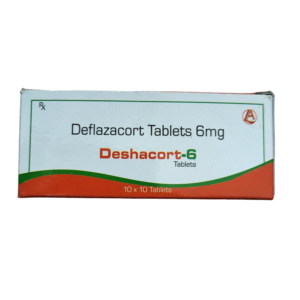Description
Cefuroxime Axetil Tablets IP 500mg is an antibiotic used to treat a variety of bacterial infections. It belongs to a class of antibiotics called cephalosporins, which are similar to penicillins in their mechanism of action.
Active Ingredient:
- Cefuroxime Axetil: This is the prodrug of Cefuroxime, meaning it is converted to Cefuroxime in the body after it is absorbed. Cefuroxime is a second-generation cephalosporin antibiotic that works by inhibiting bacterial cell wall synthesis.
Mechanism of Action:
- Cefuroxime works by inhibiting the synthesis of bacterial cell walls, which leads to the disruption of the cell wall and causes bacterial death. It is effective against both gram-positive and gram-negative bacteria.
- Being a beta-lactam antibiotic, Cefuroxime interferes with the peptidoglycan synthesis, which is a crucial component of bacterial cell walls, leading to the rupture of the cell wall and subsequent bacterial death.
Indications:
Cefuroxime Axetil is used to treat infections caused by susceptible bacteria, including:
- Respiratory tract infections:
- Pneumonia
- Bronchitis
- Sinusitis
- Pharyngitis (sore throat)
- Ear infections:
- Otitis media
- Urinary tract infections (UTIs):
- Cystitis (bladder infection)
- Pyelonephritis (kidney infection)
- Skin and soft tissue infections:
- Cellulitis
- Abscesses
- Gonorrhea: It can be used to treat this sexually transmitted infection.
- Lyme disease: Cefuroxime is also used for treating Lyme disease, especially in early stages.
Dosage and Administration:
- The usual dose for adults is 500 mg once or twice daily, depending on the infection being treated. This can vary based on the severity of the infection and the specific recommendation of a healthcare provider.
- For children, the dose is typically adjusted based on the child’s weight and the type of infection.
- Administration: Cefuroxime Axetil should be taken with food to enhance absorption.
- The course of treatment should be completed as prescribed by a healthcare provider, even if symptoms improve, to prevent antibiotic resistance.
Side Effects:
While Cefuroxime Axetil is generally well tolerated, some potential side effects can include:
- Common side effects:
- Diarrhea
- Nausea and vomiting
- Abdominal pain
- Rash
- Headache
- Serious side effects (though rare):
- Severe allergic reactions: Symptoms can include swelling, itching, difficulty breathing, or anaphylaxis.
- Clostridium difficile-associated diarrhea: A serious gastrointestinal infection.
- Liver problems: Signs include yellowing of the skin or eyes (jaundice).
- Severe skin reactions: Such as blistering or peeling skin.
- Blood disorders: Rare, but may cause low white blood cell count (leukopenia) or low platelet count (thrombocytopenia).
Precautions:
- Allergic reactions: Patients with a history of allergic reactions to cephalosporins, penicillins, or other beta-lactam antibiotics should avoid using Cefuroxime Axetil.
- Kidney problems: Use with caution in patients with kidney impairment, as dosage adjustments may be required.
- Gastrointestinal issues: If there is a history of gastrointestinal disorders, especially colitis, caution is advised.
- Pregnancy and breastfeeding: Cefuroxime Axetil should be used during pregnancy only if the benefit outweighs the risk. It is excreted in breast milk, so breastfeeding mothers should consult a healthcare provider before using it.
Drug Interactions:
- Antacids: Antacids containing magnesium or aluminum may reduce the absorption of Cefuroxime Axetil. It is recommended to take Cefuroxime at least 1-2 hours before or after taking antacids.
- Probenecid: This drug may increase the levels of Cefuroxime in the blood, so caution is needed if used together.
- Blood thinners (e.g., warfarin): Cefuroxime can sometimes affect blood clotting, so monitoring may be required.
Storage:
- Store in a cool, dry place, away from moisture and direct sunlight.
- Keep the medication in its original packaging and out of reach of children.
Summary:
Cefuroxime Axetil 500 mg is a second-generation cephalosporin antibiotic effective against a wide range of bacterial infections, including respiratory, urinary, skin, and soft tissue infections. It works by disrupting bacterial cell wall synthesis. The medication is typically taken with food for better absorption, and the full course should be completed to avoid antibiotic resistance. Side effects are generally mild, though serious reactions, including allergic responses and gastrointestinal issues, may occur. Always follow the prescribed dosage and consult a healthcare provider for proper guidance and management.
















Reviews
There are no reviews yet.